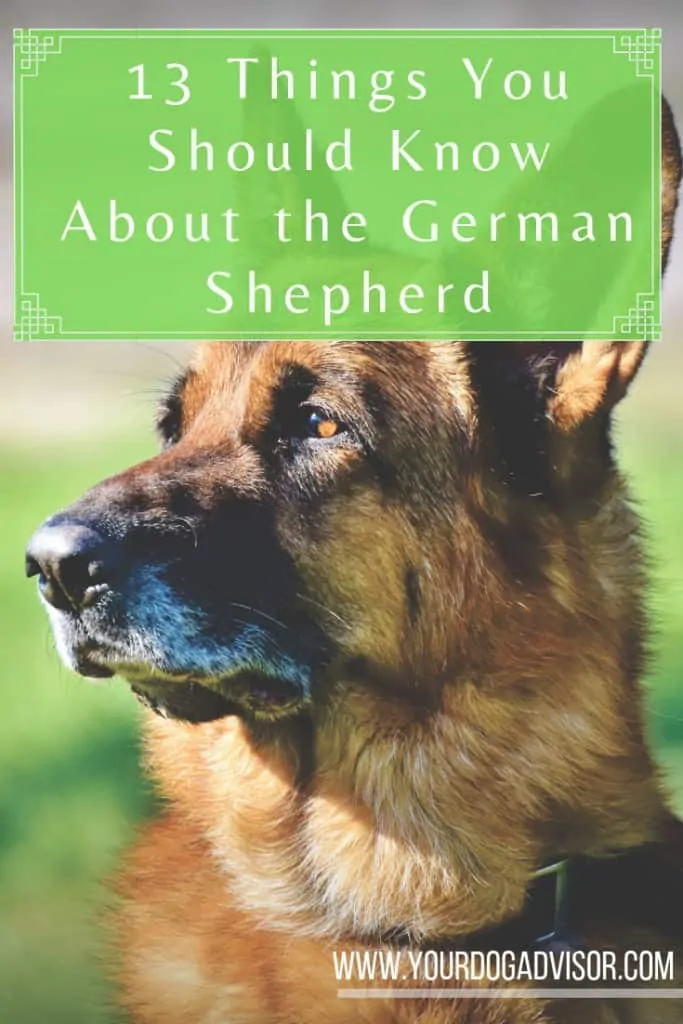So you’re thinking about getting a new dog or puppy and you have several things on your list that are must haves: loyalty, intelligence, and protection. A German Shepherd certainly fits into all of those categories and more. However, German Shepherds do require a little extra work. Before adding a German Shepherd to your family, it’s good to become acquainted with their unique characteristics. Here are 13 things that I think any future German Shepherd owner should know.
Before adding a German Shepherd to your family, it’s good to become acquainted with their unique characteristics.
Contents
1. History
In the 1850s, German Shepherds were bred for herding and protecting livestock. Local communities attempted to standardize the breed but instead created several variations of the breed that, although they could do all of the things the breeders had intended, were not standard in appearance or skill. Max Von Stephanitz of Germany is credited with first creating the German Shepherd that we see and know today in the late eighteenth century. Von Stephanitiz developed the herding dog into a working dog that would be relied upon for its speed, intelligence, and courage. Because of the breed’s incredible traits, German Shepherds were greatly implemented in World War I by the Germans. German Shepherds eventually made their way to the United States in the early 1900s after soldiers brought them back from Europe. There was skepticism and controversy over keeping the word “”German” as part of the name due to anti-German sentiments after World War I. In the UK, the German Shepherd was referred to as the Alsatian Wolf for decades until 1977 when German Shepherd again became the registered name.
2. German Shepherds are known for their intelligence and trainability
Due to their exceptional curiosity, German Shepherds like to use their nose to get into everything and everyone’s business. This is why German Shepherds are commonly used for a number of police and military services, including bomb and drug detection. You may see them riding along in the back of a police cruiser, chasing down a suspect while wearing a bullet-proof vest, or assisting with cadaver searches. German Shepherds have been trained for search and rescue missions and were essential during the 9/11 Terrorist Attack in the United States. The first service dog was actually a German Shepherd, who was trained as a seeing eye dog in the early 1920s.
With great intelligence and training also comes a high level of obedience. German Shepherds can be trained to listen, follow, and understand quick commands. German Shepherds used by law enforcement are trained to respond immediately to their handlers in life or death situations, and have the tenacity to work beyond the capabilities of their human counterparts.
In the below video, you can see how quickly and precisely German Shepherds can be trained to act and respond on command.
3. German Shepherds are active and require stimulation
German Shepherds were historically bred as working dogs and are inherently high-energy. German Shepherds can become bored and potentially destructive if they do not get the amount of exercise and stimulation that they require. A characteristic that you’ll find frequently in German Shepherds is their need to run in circles just to get their energy out. German Shepherds at police training facilities will frequently trot along the confines of their kennels, sometimes for long periods of time. Since they are such an athletic and energetic breed,German Shepherds are great for people with active lifestyles. This doesn’t require that you be a marathoner or an outdoorsmen. Spending an hour at the dog park, throwing the ball in your yard, or taking your German Shepherd out for a brisk walk are all great ways to keep your German Shepherd active and happy.
An hour a day of exercise and play is a good routine for you and your German Shepherd.
4. Their Size and Body Was Not Designed by Accident
German Shepherds, on average, weigh between 75 to 95 Ibs. Males generally stand at 25 inches tall and females at a slightly smaller average height of 23 inches. German Shepherds are longer than they are tall, enabling them to take long strides. Consequently, German Shepherds will trott to their destination, rather than take their time getting there. The hindquarters are well developed and muscled, enabling German Shepherds to travel distances quickly and the ability to jump incredible heights. German Shepherds used by law enforcement swat teams are often trained to leap into attics and other high areas where suspects might be hiding, sometimes by using a swat officer’s shield as a launch point. They are also capable of scaling walls and leaping over fences.
5. Grooming and Care
German Shepherds have double coats and do require frequent brushing. Brushing their fur every couple of days will help maintain their coat and keep their loose hairs off your furniture. German Shepherds typically shed heavily once or twice a year, especially during the warmer months. The best types of brushes for German Shepherds are brushes that can handle double coats. Out of the four types of dog brushes available on the market, rake brushes and pin brushes are best for double coats and catching loose hairs. According to the American Kennel Club, it’s also recommended that you grind or trim your German Shepherd’s nails every month as a part of their routine care.
Since German Shepherds are active dogs, they require a healthy diet that is formulated for large breeds and high energy. Like any other breed, German Shepherds have their own unique needs. Foods that include ingredients to assist with the prevention of muscular and joint conditions is recommended. Watching your German Shepherd’s weight by avoiding overfeeding will also assist in keeping your German Shepherd healthier, especially in their adult years. Our article on the best foods for German Shepherds provides further information and details about specific diet concerns and recommendations.
Frequent brushing and monthly nail trimming should be a part of your German Shepherd’s routine care.
6. German Shepherds Come in Different Shades
Black and tan variations are the general coat characteristics of German Shepherds, but German Shepherds can also be born entirely black or white. Our article about white German Shepherds discusses in greater detail the unique characteristics of white German Shepherds and some of the common misconceptions. Other color variations include: black and red, gray, and sable. Their coats are mostly a medium length, but some German Shepherds can have longer hair, depending on their genetics.
7. Personality
German Shepherds are intelligent, devoted, and fearless dogs. One of the misconceptions about German Shepherds is that they are naturally aggressive. German Shepherds are indeed protective, but they are generally great with children and other pets. German Shepherds have earned the reputation with children as being both a babysitter and a cop, because of their gentle nature and protective instincts. Because German Shepherds are naturally protective, they can sometimes be wary of strangers, but with a little patience, German Shepherds can love up to anyone. German Shepherds are loving and affectionate, and have been known to literally risk their lives for their owners. For young German Shepherds, early socialization and obedience training are highly recommended by the American Kennel Club.
German Shepherds are intelligent, devoted, and fearless dogs. They are naturally protective and do well in families and with other pets.
8. Adaptability
German Shepherds are large dogs with a lust for activity. They do not generally adapt well to small spaces, such as apartments, and do better in homes with large yards. Having extra space for a German Shepherd to run and exercise on its own is recommended. However, as long as they receive the adequate amount of exercise and stimulation that they require, German Shepherds can do well in most households.
9. General Health Concerns
German Shepherds are generally healthy and have an average life expectancy of 10 – 12 years. However, German Shepherds are predisposed to some health conditions, though many of them can be prevented:
Hip Dysplasia – Since German Shepherds are large dogs, they are prone to hip dysplasia. Hip dysplasia affects the joints and hips and can potentially lead to arthritis. Hip dysplasia can be painful and greatly affect your dog’s mobility. Keeping your German Shepherd active and on a diet that includes ingredients or supplements for joint health may reduce the risk of hip dysplasia or other joint related conditions.
Bloat – bloat is a life-threatening swelling in the abdomen due to pressure from air and gas. This is mostly common in deep-chested dogs. The swelling and pressure can cause the stomach to twist and prevent proper blood flow to the heart. Bloat occurs suddenly, so it’s highly recommended that dog owners take preventive steps to ensure that it doesn’t occur. Feeding your German Shepherd small portions throughout the day instead of one large meal will help prevent your dog from developing gas and bloating. Other steps include: slowing your dog’s eating habits, avoiding exercise after meals, and limiting access to water if your dog tends to drink too fast.
Degenerative Myelopathy – Degenerative Myelopathy is a progressive disease that affects their hindquarters. Eventually, it may lead to paralysis in the dog’s back legs.
Despite these potential issues, German Shepherds are a sturdy and healthy breed. Annual visits with your veterinarian will help ensure that you take the necessary steps to prevent such conditions and maintain your dogs healthy lifestyle.
German Shepherds are generally healthy and have an average life expectancy of 10 – 12 years, but are predisposed to certain health conditions.
10. Why the Big Ears?
Adult German Shepherds have iconic ears that naturally stand straight up. Like most dogs, German Shepherds are not born with perky ears. German Shepherd puppies are born with floppy ears that generally perk up somewhere between 4 – 7 months. Puppies will sometimes have their perky ears droop during the teething state because the calcium in their body is being directed to their developing bones and teeth. Normally, once the cartilage is fully formed, the ears will permanently stay pointed and upright. So what are those big satellite dish ears for? They enable German Shepherds to have maximized hearing capabilities because of their tall and curved shape. This is why you’ll often notice German Shepherds perking and flexing their ears when they detect a sudden noise. Besides being genetic tools for survival and efficiency, they add to the breeds regal appearance.
The tall curved shape of the ears enable German Shepherds to have more efficient hearing.
11. Bite Strength
Bite Force in dogs is measured in pounds per square inch (PSI). This equates to how much force is exerted on a square inch area. German Shepherds have been trained as attack dogs in law enforcement and with good reason. German Shepherds have one of the strongest dog bites with a bite force of 238 PSI. To put that in comparison, humans have an average bite force of 120 – 140 PSI. The saltwater crocodile is credited with having arguably the strongest bite force in the animal world at 37,000 PSI. Needless to say, you don’t want to find yourself on the wrong end of a German Shepherd, or a saltwater crocodile, of course.
German Shepherds have one of the strongest bites among dogs with a force of 238 PSI.
12. Types of German Shepherds
There are five types of German Shepherds that each have unique characteristics and breeding standards. The American Show Line is bred primarily for showing, hence the name. This type generally requires less exercise since they are bred primarily for appearance and not for work. This type also has a more pronounced angulation to their hindquarters. The West German Show Line is bred entirely for beauty and requires a strict healthy report before they can be bred. The West German Working Line is bred for work efficiency. They can be trained to do a number of working jobs and will excel at them. They are the modern representation of the original breed created by Max Von Stephanitz. Finally, the East German Working Lines is rugged, with dark coat pigmentation, a large and muscular figure, and stamina. Due to strict regulations by the government following World War II, this line has developed into quite the powerhouse. They require a great deal of work and are not recommended for the inexperienced dog owner.
13. German Shepherds in Hollywood
In the United States, the popularity of the German Shepherd exploded with the appearance of Rin Tin Tin. After his service in World War I, Corporal Lee Duncan brought a German Shepherd puppy back home with him to the United States. That puppy, Rin Tin Tin, became the first international canine superstar. He appeared in a number of films and was so popular that he received fan letters on a weekly basis. Rin Tin Tin was often depicted as a hero in films, earning German Shepherds the reputation that we still recognize today. The stardom of Rin Tin Tin made German Shepherds one of the most sought after dogs in America. You can watch the opening theme and closing credits to Rin Tin Tin in the below video.
Is the German Shepherd Right For You?
Now that I’ve told you the 13 things that you should know about the German Shepherd, here are the high points that I think are key:
Points to Remember
- German Shepherds are an active breed that requires daily exercise and mental stimulation
- German Shepherds are great family pets, but early socialization during the puppy ears is recommended
- They require frequent brushing and monthly nail trimmings, but otherwise are easy to groom and care for
- They are a healthy breed, but are predisposed to muscular and joint issues like Hip Dysplasia, and gastrointestinal issues like Bloat
- They can be trained to accomplish impressive tasks or will happily just cuddle up on the couch with you to catch up on old episodes of The Adventures of Rin-Tin-Tin
German Shepherds are an incredible breed that most dog owners can make a part of their family with the right training and care. If you want a dog that will be devoted and loyal, will outsmart your child, and inspire you to get off the couch, then the German Shepherd is the companion for you! They have rightly earned their place as one of the most sought after breeds in the United States.







